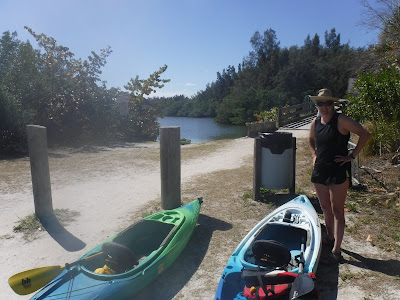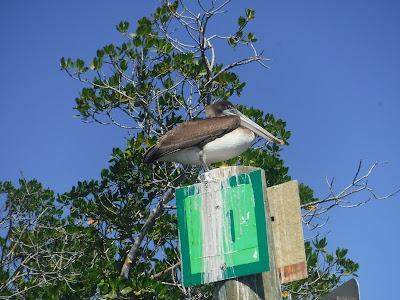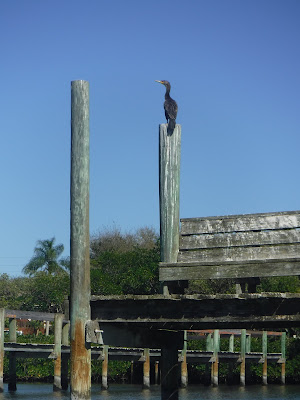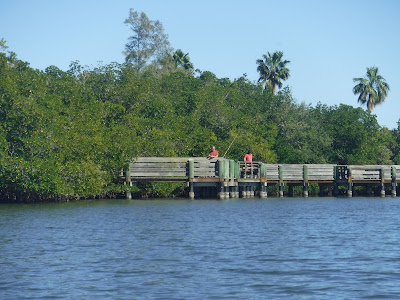Today was a repair day in Fort Pierce, Florida. The molding on the lower front edge of our driver-side slide-out had popped out (cheap screws sheared off), and we had to reattach and secure the molding. This has happened before, unfortunately, so we're experienced at this particular repair, and it only took a couple hours. This left us the whole afternoon to play. We had a day off from our friends in Stuart, so we decided to paddle our kayaks again, even after having paddled just yesterday.
A little research told us that the Fort Pierce Inlet State Recreation Area, just across the North Causeway from us, should be an interesting paddle, so we drove the 2 miles or so over to put into the inlet. Here is a map of part of the recreation area, showing our paddling route from North Causeway Island Park:
Our entire paddle was less than 4 miles, but it took us through a variety of water environments: up through the Spoil Islands, across into Snapper Cut, down and up into St. Lucie Cut, and then back across the Inlet to the shoreline and return to our point of embarcation.
Where we launched was just next to the main Inlet channel, and, waiting to cross the channel with its heavy boat traffic made us think of standing on an Interstate highway and getting ready to race across to the other side. Here, Kathy braces herself for the paddle across the busy channel:
We made it safely across and, reaching the first Spoil Island, we happened upon a perching area for local pelicans -- there were so many that we couldn't count them!

The Spoil Islands in the Fort Pierce Inlet area are among 137 spoil islands formed in the Indian River Lagoon from 1953 to 1961 when the U.S. Army Corps of Engineers dredged the Intracoastal Waterway — the main channel through the center of the lagoon. The Corps left behind heaps of sand on either side of the channel. Although federal government created the islands, the channel and surrounding spoil islands have become the state's responsibility, with oversight from the Florida Inland Navigation District. The district manages the channel through 11 coastal counties, including St. Lucie County, where we paddled. The state owns most of the spoil islands, although about a dozen are owned by private or other government interests. The lagoon's islands teem with exotic plants, including trees with shallow roots that provide little erosion protection and collapse during storms. The islands were created as an unintended consequence of digging the Intracoastal Waterway. As the waterway was dredged, the "spoil" was dumped along its edge forming a string of islands. Seventy-one of these islands have been designated recreational islands, open to the public for day use and primitive camping.
Today, to paddlers such as us, the islands appear nearly natural, with lush mangrove forests covering them:
Wading birds and other waterfowl teem in the waters, challenging us to catch photos of all of them:
As we paddled from one Spoil Island to the next, we looked closely at the tangled root systems of the mangroves, noting deposits on them that reminded us of lichen or salt deposits. But then, even among the harsh colors of these deposits and the brown-gray of the roots, strange, colorful plant life appears:
After checking out 4 or 5 of the Spoil Islands, we paddled up Snapper Cut, which is said to be home to manatees. However, today we did not see any of those mythical mermaid creatures. We did spy the infrastructure work for roads on Jack Island:
The manatees are not scarce because of lack of protection. Signs along the waterway enjoin boaters to move slowly in order to avoid disturbing or harming those slow, friendly creatures:
The Great Blue Heron is probably the most shy of the wading birds; they always flee as soon as they are aware that we approach in our kayaks. Nevertheless, we occasionally surprise them and get close enough to snap a photo as the temperamental bird flees:
For whatever reason, this heron was sure that, by standing on a sandbar in the middle of the lagoon, he/she was safe from our approach. S/he let us get close enough for a real portrait:
Kathy spotted what looked like a grounded boat in St. Lucie Cut as we were paddling far across the lagoon in the Spoil Islands. When we got over to the Cut, we had a chance to examine it more closely. It appeared to have been abandoned for more than one season, with encrustations and dirt piling up on it. It had been stripped of its motor and most other equipment, although, inexplicably, two valuable winches were still attached to the deck:
And then there was a pretty egret who let us take her portrait:
Crossing St. Lucie Cut and back across the Fort Pierce Inlet Channel required us to cross the busy lanes of boat traffic using the channels. This was not for the faint of heart. We made the crossings safely enough, but as we returned to the shoreline and paddled down to our put-in, we were forced near the channel by the very shallow waters along the shore. For some reason, the boaters in the Inlet Channel enjoyed passing at full speed, and we "enjoyed" the high waves of their wakes. Each of us was splashed in turn, and, while we got drenched, the water felt refreshing in the hot Florida sun.
We made it back to our launch site without injury or shipwreck. Interestingly, as we were loading our kayaks, a St. Lucie County Sheriff cruised up and parked by us to watch us load. We weren't sure the reason -- perhaps the officer thought we had parked illegally, or perhaps the officer wasn't sure we were loading in the right spot. But, in any event, as we finished loading, the officer moved on, apparently satisfied that we and our activities were harmless.
We finished the afternoon stopping by a kayak shop in nearby Vero Beach to purchase extra pads for our kayak seats, to help out sitz bones survive long paddles in somewhat greater comfort in the future.
Afterward, it was home and dinner, a phone conversation with our daughter, and plans for an outing of arts and music with our friends again in Stuart.
Nighty-night!

























































